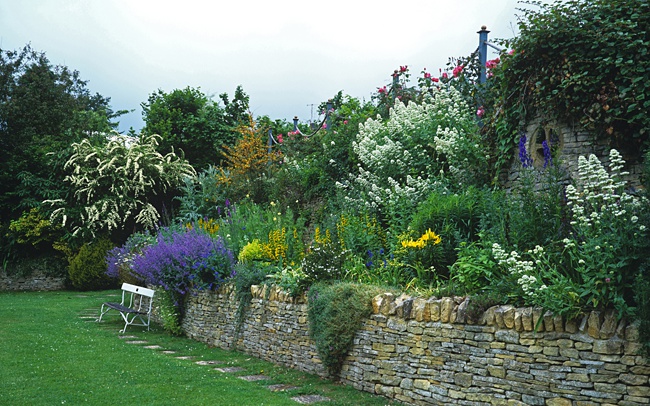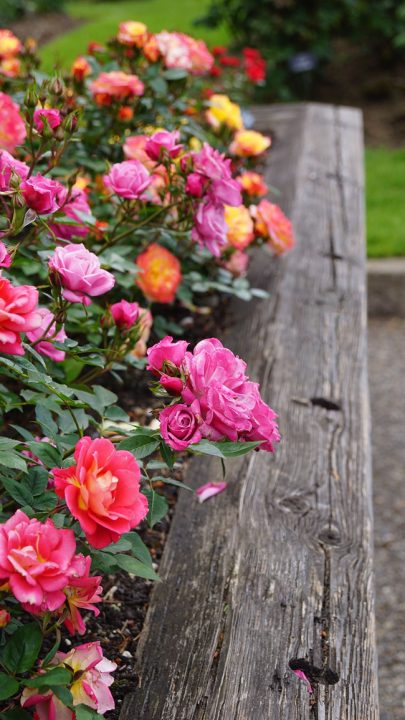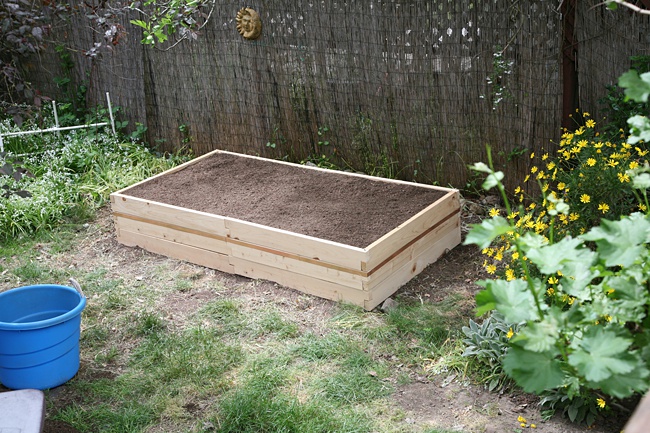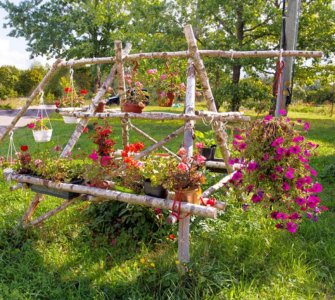Due to the fact we have no garden, but a ton of space around our property, I’ve been thinking about how to build a raised rose bed lately. Is it possible that I could still have my cut flower garden dream, without having an actual garden!?
In case you’re new to gardening, a raised bed is an elevated unit of soil, approximately 3 to four feet wide, usually encased in concrete, brick, or wood. Raised beds are used to segregate different areas of your garden, and they can prevent pests and weeds from impacting the growth of your plants, flowers and vegetables.
Unlike containers, raised beds have no bottom, which allows the soil to drain. This means plants that need well-drained soil – such as roses! and vegetables such as root vegetables, onions, and leafy greens – grow particularly well in raised beds.

Disclosure: This post may contain affiliate links, which means that we may earn commission from qualifying purchases at no extra cost to you. Learn more.
A raised bed gives a garden shape, structure, and interest. In general it can help your garden look well designed and like you’ve added features to it, rather than just dumping everything along the edges of a garden like an inexperienced gardener might do! (waves). They can be easy to make with wood, or for period properties crafting them out of brick and stone looks elegant, and compliments the age of your property.
Table of Contents
Can I Grow Roses In A Raised Bed?
Roses grow well in raised beds, as a raised bed increases soil drainage, and roses thrive in well-drained soil. A raised bed can also protect your roses from aphids and other pests such as squirrels and even deer.
Raised beds also make great starter sites to get roses established, before transferring them into the rest of the garden. That way the new roses have the best chance of survival as seedlings and new plants, before you transfer them into other areas of your garden once they reach a year old or older.
At this age, they will be strong enough to withstand ‘transplant shock’ which can occur when you move roses from one location to another, and you will have protected them from weeds and pests when they are at their most vulnerable.
What Do I Need To Build A Raised Rose Bed?
To build a raised rose bed, you will need your allocated space (approximately 4ft x 4ft as an average size and shape), the correct positioning (that gives your roses approx 6-8 hours sunlight, is away from shaded areas and trees which take up your roses nutrients), your rose seedlings or established plants ready to transplant into your rose bed, and the following equipment. (This DIY raised rose bed will take less than an afternoon to build). You will also need a raised bed lining (newspaper is great at killing grass if you are building on top of your lawn), and soil mix (you can work how much soil you need by multiplying the width by the length by the height of your raised bed).
- 4 wooden planks (pre-treated is best) of desired size for your space, maximum 4ft (1.2m) wide
- for square raised rose beds, use 4 identical wooden planks (same length, width, height)
- for rectangular raised rose beds, 2 planks will be shorter, and 2 will be longer (width and height should remain the same!)
- 16-20 rust-proof nails, about 10-15 cm in length
- 4 wooden corner pegs
- preservative for wood (if untreated!)
- hammer
- shovel
- clamps
- drill
- L-square ruler (or measuring tape)
- potting mix
How To Build A Raised Rose Bed
Consider Size
The ideal size for a raised rose bed is approximately 4 feet wide (1.2m) x 4ft. This will produce a square raised rose bed, although rectangular shapes can be popular and allow for you to not step on your newly-flourishing roses when tending to them. The longest side should not exceed 4 feet wide, unless you are making a very long and thin bed, in which case you would want your shortest side to be no longer than half a meter.
Position
Your roses will need approximately 6-8 hours of sunshine per day, so you’ll want to position your raised rose bed out of shaded areas.
You’ll also need to keep your raised bed away from trees and other large plants in your garden, as their long roots will leech away the water and nutrients away from your raised bed soil.
You will need to consider your water supply when positioning your raised rose bed – will you irrigate your roses via a sprinkler or water system, or will you be there daily to water them by hand? A simple sprinkler system can ensure your roses receive the water they need but you’ll need to ensure your raised bed is within comfortable walking distance of your water supply.
(If you want to make watering your roses in your raised bed super easy, check this out. It’s my go-to watering system, mainly because it comes boxed with instructions whereas everything else seems to come in plastic packets and expect me to have the genius garden-know-how needed to set it up by myself. Noooo, give me the step by step, please! So go here to make watering your rose raised bed super simple)!
What roses grow best in raised beds?
All roses that do well in pots will do great in raised rose beds as well! However, if you can meet the three sacred conditions of rose gardening (sunlight, good soil, water), I urge you to give it a try with just about any rose variety. The great thing about raised rose beds is that, while you do isolate and “raise” your garden, both are interconnected. Raised rose beds do not have limited soil like pots do. This can be a blessing for roses that are very heavy on roots.
Still, if you want to play it safe, you can’t miss with these beauties:
- Eustacia Vye
- Olivia Rose Austin
- Susan Williams-Ellis
- Dame Judi Dench
- Open Arms
- Golden Celebration
Where should I place the raised bed?
Considering it is raised ROSE beds we’re talking about here, depending on your variety of choice, you might be a little bit limited as for the location. If you place it on the northern side of the house, you effectively create a shade garden. This will likely limit you in rose variety choice. Keep your bed away from trees, fences, walls and other shade and make sure the position allows for at least 6-7 hours of full sunlight.
If you want to be able to plant just about any rose, choose west, east and south parts of your home and garden to place your raised bed at. However, there is a very neat trick I am SUPER excited to share with you today that has made my gardening life tons easier. Visit SunCalc, type in your address (or drag the location slider to it) and you will be able to find out precisely how and when sunlight hits your home! No more worrying, no more head OR paper calculations!
How long does it take to make a raised rose bed?
Depending on what materials you already have at hand (and for which you have to take a trip to Home Depot), expect this to be a single afternoon project at best. In case you need to proof the wood with a preservative, you will need to wait a day before you affix your raised bed into the soil.
While the raised bed can be DIY-ed, placed into ground and filled with soil in about one afternoon’s time, do not start planting the same day. The raised bed needs to settle and become one with the rest of your garden. You might see some sinking during this time. In case of sinking, fill up the raised bed with more soil. The process of settling might take up to a week. After that, it is safe to start planting knowing there is sufficient structural integrity to hold your roses.
What is the minimum size required for a raised rose bed?
For a smallest possible rose bed, you can create a raised rose bed at minimum half a metre by half a metre – 50cm x 50cm! That’s a pretty small raised rose bed, but it can look good to have la group (6-10) of them as a design feature. One small raised rose bed might be required if you are looking to protect a precious plant eg one that is inherited, or a rare species, and you’re aiming to protect it from weeds and pests and provide optimal growing conditions.
Bear in mind that the size has to accommodate for your rose at full maturity, or you will need to transport your rose into a standard rose bed once it outgrows the raised rose bed and the branches hang over the edges of the bed.
More important than the width and length of the raised bed is the depth of the raised bed.
How Deep Should A Raised Rose Bed Be?
You will need your raised bed height to be approximately 22 inches in order for your rose to root properly, although the height of your actual bed on the ground might be lower if you are planting on grass or soil. Rose roots will not need to grow outwards, it will simply grow downwards instead, so it is essential there is enough height in your raised bed to allow your rose to root properly.
If your raised bed sits over concrete, metal, brick or other material, then your raised bed height must be at least 22 inches for your rose to root properly and for your rose to be able to receive the water and nutrients it needs.
The height of your raised rose bed also depends on how sick of bending over you are during gardening! I jest, but creating a tall raised rose bed is great for our elderly readers, allowing them to stave off back pains while tending to their favourite blooms. Keep in mind that raised rose beds over 60 centimetres of height will likely need additional support systems. A cross-support can be made or bought from wood or welded from aluminium, after which it is bolted down the centre to prevent the wooden sides from caving in under pressure.
What is the maximum size for a raised rose bed?
While there is no hard maximum, anything over 2 by 2 by 1 metre might become unstable under the combined pressure of soil, water and growing plants. Optimally, opt to create multiple (aptly spaced) raised rose beds, which will give a much nicer visual effect, as well as be structurally safer for your plants.
Length and width of your raised rose bed is variable, and depends entirely on the amount of space you have. It should be noted that the bigger the rose bed, the more inner support structures you will need to have. This only applies for rose beds over 1,5 x 1,5 meter, so don’t be too worried about this for home garden use.
While measuring, don’t forget to account for the fact that you still have to garden in your raised rose bed! Measure accordingly so that you have plenty space to move around your garden, bend, kneel or even sit down next to it as you’re tending to your roses. The whole point of a raised rose bed is not to tread on it as you garden, so be certain to leave yourself some space around to manoeuvre your body and tools.
If you’re considering creating multiple raised rose beds and have vast space in your garden, consider that the spacing between beds should be equal.
Meaning, the distance from each of the beds should be the same, or at the very least, you should have some symmetry in your spacing.
Is a raised rose bed hard to make?
You will need one afternoon’s worth of time to build a raised rose bed DIY project. It might be a bit challenging if you’re absolutely unfamiliar with woodwork, but this tutorial is geared towards complete beginners and safe to do even if you’ve never operated a handsaw. If you take care to choose pre-cut, pre-measured and pre-treated wood, the rest of the work is just assembling a frame and putting it into the ground. No need to feel unsafe handling heavy woodworking power tools!
Keep in mind that raised rose beds over 60 centimetres of height will likely need additional support systems. A cross-support can be made or bought from wood or welded from aluminium, after which it is bolted down the centre to prevent the wooden sides from caving in under pressure.
What do I put on the bottom of a raised rose bed?
Before you position your raised rose bed into the ground, completely remove all weeds, rocks, grass and uneven soil. (This might be sad for your turf, but you can put your grass to good use and compost it for your roses)!
Digging through the soil and removing grass, weeds and debris is important. These plants will continue to grow if covered with soil, interfering with rose growth as time passes. They will compete with your rose for nutrients and water, depleting the rose’s ability to flourish.
I don’t recommend using a herbicide to kill off the grass, as there is a chance this could leech into your soil in the raised bed. Instead, place a thick layer of newspaper on top of the grass before build your raised bed over it. This will kill the grass but will also serve as a form of compost for your roses over time!
What To Line A Raised Rose Bed With
Lining a raised rose bed helps prevent weeds growing up and through your raised bed, helps kill off any remaining grass or grass seed that might otherwise leech nutrients and water from your plants, and protects your roots against burrowing animals such as gophers or moles. So, what to line your raised rose bed with?
Landscape fibre
Place a sheet of landscape fibre at the bottom of your raised rose bed for protection. The fibre has plenty of small holes in it which help your soil to drain well.
Cardboard
For durable protection, choose cardboard which will outlast newspapers. Be aware that you will need to puncture some drainage holes, as cardboard itself might water-log the soil.
Fine mesh wire
Possibly the best option! Fine mesh wire netting is an excellent raised bed lining as it provides excellent drainage for your soil. At the same time, it will also allow roots to penetrate deeper into the ground below. Finally, fine wire mesh will do a great job at keeping out pests.
Should I use potting soil on my raised rose bed?
Usually, your run-of-the-mill garden soil will simply not be good for your raised rose bed. The issue lies in the type of the soil (which is often misfitting for capricious roses!), but also in its density. Garden soil is typically too dense for raised beds in general.
The soil you use in a raised rose bed should nicely complement what a raised bed already provides – namely, airflow, good drainage and defense against critters. For that choice, a rose potting mix will do well. Alternatively, it’s a great choice to whip up your own batch of potting soil. 1/3 perlite/vermiculite, 1/3 peat moss and 1/3 compost with a dash of bone meal, cottonseed meal and lime is a mixture we will swear by!
How much space does a rose bush need from other rose bushes?
To be able to properly space roses apart, consider the size of your variety at full maturity. Space your roses out from 50 to 60 centimetres apart. This ensures your roses can each get adequate nutrients from the soil and water. Really large shrub roses (the kind that can grow to 10 ft +, such as the Portlandia and Morletti varieties)! feet will need about 60 to 70 centimetres apart.
With smaller and miniature roses, you can probably get away with spacing them only about 20 to 30 centimetres apart. These parameters depend greatly on the variety.
Finally, if you live in colder parts of the world, consider planting the roses closer together. If you live in tropical parts, give them a bit more space. This is about the only time where you should take air circulation REALLY seriously!
Can I plant new roses on an old rose bed?
In rose literature sourced from England, you might occasionally read about an ailment called “sick soil syndrome”. Planting a new rose where an old rose has been can make a new rose grow poorly. It might even wilt altogether.
The full cause is not known. It is speculated that anything from microflora and microfauna, toxins to nutrient-poor soil might cause this to occur. As such, rosarians will generally recommend waiting a full season before planting a new rose in the spot of an old one.
If you’re very impatient, you can try raking and mulching the area thoroughly. After that, plant a very hardy and resistant rose at the location. However, I guarantee no success! According to gardener stories, it is about a 50-50 chance you will encounter this peculiar drawback.
How to build a raised rose bed – a step-by-step tutorial
- Use your shovel to take off any turf, grass or weeds from the surface of your area. Rake the soil to remove any stones, and debris that do not belong.
- Lay out your wooden planks in your desired shape. Starting with one edge, place a wooden peg on the inner side. This will be used to propel and hold the structure firmly in place in the ground.
- With a corner made using two planks and a peg on the inner side directly at the inner side of the corner, fasten everything firmly with a clamp. Make sure the corner is 90 degrees.
- When satisfied with positioning, drive in about 4 to 5 nails into the corner with a drill. Be sure to affix the wooden peg firmly as well in the process.
- Repeat this on the other three corners of the raised rose bed. Use an L-shaped ruler to make sure all corners are 90 degrees. Otherwise, you can use a measuring tape. Measure the diagonals of the raised rose bed – you will know you did well if they’re equal.
- Coat the wooden pegs with wood preservative and allow to dry. You can skip this step if you used pre-treated wood!
- Position your raised rose bed into place at location. Using a long plank, cover the corners and use a hammer to drive the rose bed into the ground. Be gentle, but firm, and don’t hammer straight onto the corner! Always use a plank to avoid damage.
- Repeat on all corners and make sure the raised rose bed is leveled well into the ground.
- Finally, line the inside of your raised bed with your liner.
- Fill with the potting mix of your choice (or making). To figure out how much soil you need to fill the inside of your raised bed, multiply the length by the width by the height or depth. So for example if you have a 4 ft by 4ft raised bed that was 2ft tall, you would need 32 cubic feet of soil. (4 x 4 x 2).Make sure to leave about 2-3 centimetres space from the top, for adding mulch once the roses are planted.
How to plant roses in a raised bed
We have a whole guide on planting roses – whether it is the long way from a seed, or the short way via propagation!
The easiest way to get some roses in your newly minted raised bed build is to transplant them. From a nursery rose or a bare root, gently transplant the rose. Place it into a hole in the raised bed, including the original soil in the pot. Water and leave it to acclimatise to its new location.
Generally, planting in raised beds takes a little bit of planning. Don’t be afraid to break out the pencil and drawing block and scribble your raised bed with dimensions and varieties! Take note of the varieties you want to plant and their sizes at full maturity. The area they will cover and how many roses you precisely want to plant will be your most important measure. Last but not least, keep in mind how far apart they need to be spaced. Drawing it all out might help you get a much more satisfying end product!
How to care for your roses once planted in your raised bed
Once your roses are safely in their new raised bed, it is best to keep a close eye on them. This will help you spot signs of transplant shock and help you treat it quickly. Once your roses are happy and in place –
- Water twice weekly – daily in summer and once weekly in winter. Thankfully, you don’t have to worry too much about overwatering as the raised bed provides amazing drainage. Still, don’t provide more water than necessary for your rose.
- Prune your roses. Dead, diseased, woody and broken stems should go ASAP. Otherwise, prune twice yearly and deadhead during bloom season to amplify flowering yield.
- Fertilise and feed with a balanced, organic fertiliser rich in nitrogen, phosphorus and potassium. Make your choice between some of our organic favourites such as coffee grounds, tomato feed or rice water!
- Rake the topsoil to allow aeration. Remove any debris, leaves or branches that fall to the surface of the raised bed.
- Finally, protect your roses from winter if they’re not as hardy as they should be for your zone. (Or if you’re unlucky and live really up north.) Assemble a wire mesh cover, anchor it to the ground and cover with a cheesecloth or gardening cloth. This will protect roses from the elements while allowing them to breathe.
There you have it, an elegant way to build a raised rose bed! I was super happy to find out I can build raised beds on concrete, maybe my dream of a cut flower garden isn’t that far away after all! Have you already constructed raised beds before and have tips and tricks to share? Best wood to use, best roses or something super kooky that mysteriously worked for you? Tell us all about it! The more we know, the more we grow!




